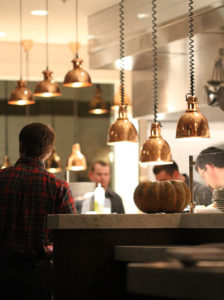
CLOSED 2012
It’s no secret that Food Network celebrity and culinary prowess usually have an inverse relationship. Most of the true heavy-hitters were thrown overboard long ago, cast into the backwaters of basic cable or pushed into the early-morning lineup. They weren’t camera friendly, used complicated ingredients and made dishes that took more than 30 minutes. God forbid.
Tyler Florence has always been the exception. With his dude-ish affability, lack of shtick and uncomplicated affection for the kinds of people actually like to eat, he is a chef’s chef with proletariat cred. And his new Napa restaurant, Rotisserie and Wine, is very much a restaurant for the people.
It’s been a busy year for Florence. R&W is his second Bay Area to restaurant to open in 2010. San Francisco’s Wayfare Tavern opened in November and he plans to open El Paseo, with rocker Sammy Hagar later this year. He has also opened two kitchen stores (in Napa and Mill Valley).
With such a whirlwind schedule, it would be all to easy to phone in Rotisserie and Wine — a fast-casual concept restaurant focused on rotisserie meats and Southern-influenced sides. Instead, Florence over-delivers with a spot-on line-up of dishes that makes decision-making downright difficult. Fortunately prices are reasonable enough for excessive generosity…

Menu Bests =
– Cheese Puffs ($3 each): Bacon mornay and melted cheese ooze from a cocoon of fried dough.
– Fried Scrapple ($5): Don’t ask what it is. Servers have been carefully trained to dance around the fact that scrapple is, in fact, everything but the squeal. Offal, scraps and other goodies are mixed with cornmeal and fried. Think of it as a piggy hush puppy.
– Duck Confit Waffles ($18): Chicken and waffles gets a Napa twist with fried duck confit, quince soffrito and endive served atop fluffy waffles and maple syrup. Unforgettable.
– Beef & Bones ($28): Prime rib eye steak, bread-crumb topped bone marrow and Yorkshire pudding. Watery horseradish needs work, but it’s a small complaint between mouthfuls of perfectly-cooked beef.
– Whipped yams with banana ($5): Pureed yams meet match with a hint of banana vinegar, yogurt and crispy yam skins.
– David Little’s Potatoes ($7): Baby ‘taters soaked in rotisserie drippings. Schmaltz-tastic.
– Cookies and milk: On the “glad we asked” list, this kindergarten favorite includes warm ginger snaps and a bacon-fat infused shortbread as heavenly to smell as it is to eat. On the side, malted panna cotta.
– Dark and Stormy: Rum ice cream, ginger beer and lime.
The Vibe: Cracker Barrel meets Pottery Barn. In a good way. There’s a homey mix-matchiness, reclaimed wood, lots of jars and the staff in checkered shirts and jeans. But way before it gets too hoedown, Rotisserie and Wine remembers where it is (Napa’s Riverfront) and classes it up with rural/urban-minimal touches (concrete flooring, wine barrel chandeliers) and reigns it all in.
 The Scene: An open kitchen and bar runs nearly the length of the restaurant, making it friendly to single diners and cocktailers. The price-point and menu makes it plenty friendly for kids and families.
The Scene: An open kitchen and bar runs nearly the length of the restaurant, making it friendly to single diners and cocktailers. The price-point and menu makes it plenty friendly for kids and families.
The Drinks: A rotating lineup of syrups mixed with soda or sparkling wine are refreshing starters. Beet syrup isn’t quite as alarming as it sounds. Plenty of local and not-so-local wines by the bottle or glass. Anthill Farms syrah shows someone’s paying attention.
The Cost: Two “snacks”, two appetizers, two sodas, two glasses of wine, one entree (suggested for two), two sides and two desserts for a relatively thrifty (for Napa) $136.
Rotisserie and Wine, 720 Main St., Napa, 254-8500. Open nightly from 5pm to 11pm. Lunch anticipated in the coming months. Closed Dec. 24/25/31.














